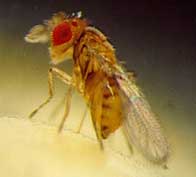 Found throughout the world, the 800 species of Trichoigramma feed on the insect eggs especially moths and butterflies. Several species feed on the eggs of over 200 different garden pests, including cabbage loopers, cutworms, and tomato horn worm. The wasps are 1/32”, about the size of a speck of dust, and do not sting so offer no harm to humans or other large animals. They are used for biological control of garden pests, with Trichogramma pretiosum being the most common species sold.
Found throughout the world, the 800 species of Trichoigramma feed on the insect eggs especially moths and butterflies. Several species feed on the eggs of over 200 different garden pests, including cabbage loopers, cutworms, and tomato horn worm. The wasps are 1/32”, about the size of a speck of dust, and do not sting so offer no harm to humans or other large animals. They are used for biological control of garden pests, with Trichogramma pretiosum being the most common species sold.
Adult females wasps do all the work. They find a suitable egg of the host insect by using chemical and visual stimuli such as shape and color of the egg, and the chemicals left by the host female when she lays the eggs. After drumming the host egg with her antennae, the female Trichogramma wasp drills a hole in the shell of the egg and uses her egg laying device, ovipositor, to deposit two or three eggs inside the host egg. A small amount of the host egg’s content comes out of the shell at this time which is eaten by the female wasp, giving her increased longevity. As the Trichogramma larva develops the host egg turns bluish black. One female can deposit one to ten eggs per day and between 10 and 190 in a life time depending on the climate and her nutrition. Although these wasps are tiny they play a significant roll in garden pest control but can be killed by insecticides and natural predators such as spiders.
A large number of plants can be used to encourage and maintain a population of Trichogramma wasps. Garden plants include fern-leaf yarrow (Achillea filipendulina), common yarrow (Achillea millefolium), golden marguerite (Anthemis tinctoria), masterwort (Astrantia major), Cosmos bipinnatus, statice (Limonium latifolium), lobelia (Lobelia erinus), sweet alyssym (Lobularia maritima), cinquefoil (Potentilla recta ‘warrenii’and Potentilla villosa), purple poppy mallow (Callirhoe involucrata),stonecrop (Sedum kamtschaticum), summer beauty (Allium tanguticum), marigold (Tagetes tennuifolia), crimsom thyme (Thymus serpylum), and Zinnia. Plants for the herb garden include caraway (Carum carvi), coriander (Coriandrum sativum), fennel (Foeniculum vulgare), lemon balm (Melissa officinalis), pennyroyal (Mentha pulegium), parsley (Petroselinjum crispum), tansy (Tanacetum vulgare), and. Plants for the wild flower garden include Queen Anne’s lace (Daucus carota) and butter and eggs (Linaria vulgaris). Avoidance of broad spectrum insecticides is also important.
To buy live Trichogramma from Amazon.com click here.
